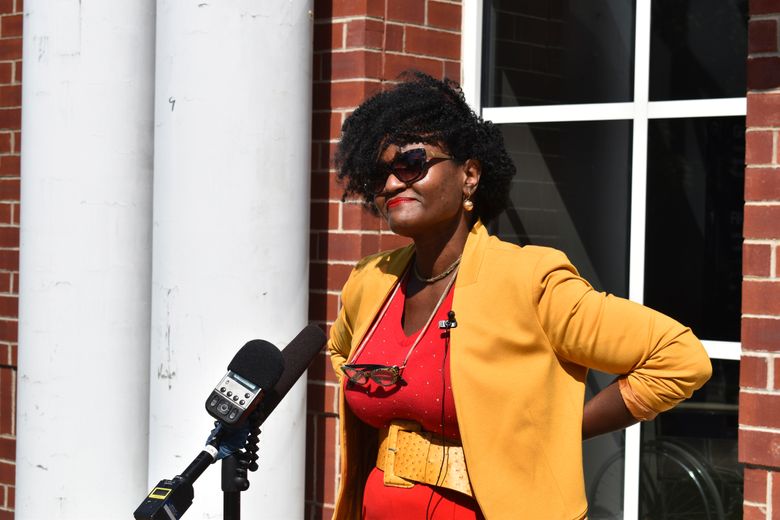
In white Adirondacks, racism may be toughest hill to climb
by MICHAEL HILLLAKE PLACID, N.Y. (AP) — Nicole Hylton-Patterson moved to the Adirondack Mountains to help make this vast, and overwhelmingly white, region more welcoming to people who, like her, are Black.
The job has not been easy.
While the death of George Floyd gave her mission a jolt of urgency, the “Go Back to Africa” graffiti on a bridge near her home spoke to her challenges. With relatively few Black people here, white people fill out Black Lives Matter rallies and host online antiracism forums.
Without diverse city streets filled with demonstrators, how do you encourage racial reckonings in rural areas like the Adirondacks, where most everyone looks similar?
“I’ve lived in enough spaces in America to tell people, ’America doesn’t look like New York City, it doesn’t look like L.A. and it doesn’t even look like Atlanta. It looks like the Adirondack Park,” said Hylton-Patterson, who became the first director of the Adirondack Diversity Initiative late last year. “It is more challenging, exponentially so. But the work still has to get done.”
The Adirondack Park covers 6 million acres of thick woods, remote lakes and commanding peaks in northern New York. More than 100,000 people live here year round, many who work in prisons, health care or tourism. White people comprise 95% of the population in some parts of the Adirondacks.
Since her arrival from the Bronx in December, Hylton-Patterson said, she has encountered only a few dozen other people of color.
That uniformity is also seen along the backwoods trails and waterways popular with hikers, skiers and paddlers. Advocates see the need for welcoming more diverse residents and visitors not only as a societal good, but as necessary to a tourism-dependent region that is losing population.
The Adirondack Diversity Initiative had been an all-volunteer effort until a $250,000 state grant allowed it to hire Hylton-Patterson, a veteran in the field. She visits police agencies to make sure officers will receive racial bias training; meets with school administrators interested in making classrooms more inclusive; and works with state environmental officials who want to make the wilderness welcoming.
She settled in the postcard-pretty village of Saranac Lake and began listening to people. Pandemic restrictions sidetracked some plans, though Floyd’s death at the hands of the police in Minneapolis made people more receptive to conversations.
“There are a lot of people who are like, ’Yeah, I wish there wasn’t racism, but I’m nice to everyone,’” said Jane Haugh, a white woman who runs the Wake the North Country, an anti-bigotry and criminal justice reform group. “And then George Floyd happened. And suddenly people were calling me and saying, ‘Jane, you’ve been talking about this for so long. Can I come talk to you?’”
Two things that happened locally this summer prompted conversations of their own.
A widely shared video of the Saranac Lake High School graduation featured valedictorian Francine Newman giving a speech about being called “Squinty Eyes,” “Ling Ling” and worse while growing up in a place where the recorded Asian population is nearly zero.
“Ignorance is bliss only for those who did not realize the utter shame and humiliation I carried over a part of myself I would never be able to change,” Newman said.
The other episode hit home for Hylton-Patterson. She was so rattled by the graffiti on a railroad bridge along her daily running route that she moved elsewhere in the Adirondacks. Gov. Andrew Cuomo said the vandalism is being investigated by the state’s Hate Crimes Task Force.
Hylton-Patterson is used to living in white areas, noting that as a child she lived on a remote island in Norway. And she’s used to the everyday racism she has encountered here, like being watched while shopping or a woman touching her hair and asking if it’s a wig.
But the graffiti made her feel unsafe.
She still stays in the public eye, hosting videos with themes like “Antiracism 101.” She took a prominent role in pressing for an investigation into an off-duty police officer who fired his gun after an encounter with Black youths. Activists greeted an initial victory this month when state police said the probe was reopened.
And the graffiti galvanized supporters, who posted hundreds anti-racism flyers around the village.
But a big issue remains in reaching people who wouldn’t think of watching an antiracism video, people who think race relations are a city problem. Some locals think confrontations like the suffocation death of Daniel Prude a few hours west in Rochester cannot happen here.
“All I can do is work with your neighbors and hopefully your neighbors will find an opportunity, a gateway to speak to you about engaging in something that might shake the foundations of who you think you are,” she said.
She plans to provide cultural consciousness and related training for as many as 100 residents who can talk to neighbors in their corner of the Adirondacks. She also is working to identify liaisons with local governments, police departments and school boards to address systemic racism.
In both cases, neighbors would work with neighbors.
“Doing this work in what is a very rural white area, we can’t put all of the pressure on Nicky to teach us and guide us,” said Chris Morris, a longtime ADI volunteer. “It is really incumbent on people who want to help to be actively learning and listening and then figuring out how they can make a difference.”